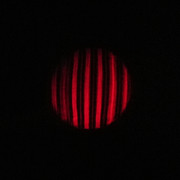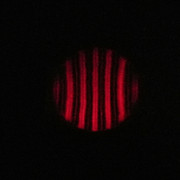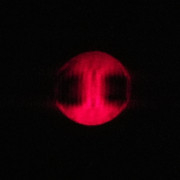- This topic has 170 replies, 5 voices, and was last updated 5 years, 8 months ago by
Giulio TiberinI .
-
AuthorPosts
-
7 September 2017 at 16:37 #10355
Stefano, consider that for an F6 it is better to use a reticle with at least 8 linee/mm, (8 black lines + 8 transparent spaces – 0,062 mm line thickness ), otherwise it becomes difficult to evaluate the deformations of the bands , while for fast mirrors the number of lines on the reticle is decreased to improve the readability of the test.
You can easily verify what has been said by doing simulations with a software for the Ronchi test, like this: http://stellafane.org/tm/atm/test/RonWin20.zip7 September 2017 at 17:23 #10356I got the one from 200 lines because they more or less are 8 per millimeter… I also took the other one in anticipation of future works. I have several simulation software and it seemed to me that just for mine they were sufficient.
But one question… Suppose that by doing a Ronchi test, not a sphere but a principle of parabola emerged, in that case it is advisable to search for the sphere in any case by inverting the tool and mirror or if the mirror is already properly polished you can continue bypassing the sphere?7 September 2017 at 19:41 #10357optimistic
 , you will see that what will come out will be neither of the two things, but one “pseudosphere” to correct, first carefully identifying which aspects there are to be optimized ( Corsica,care, pressure, adaptation, temperature,etc ) to get to a good sphere, at that point you can proceed to the parable because you have the right setup and have acquired a fundamental and preparatory working experience to attempt the parable.
, you will see that what will come out will be neither of the two things, but one “pseudosphere” to correct, first carefully identifying which aspects there are to be optimized ( Corsica,care, pressure, adaptation, temperature,etc ) to get to a good sphere, at that point you can proceed to the parable because you have the right setup and have acquired a fundamental and preparatory working experience to attempt the parable.the “ball” it is already a good test bed for a grattavetro, skipping it would mean losing a very important part of the route
7 September 2017 at 22:58 #10359therefore, I could not resist and tonight I tried to create a Ronchi lattice with a fishing line from 0,1 mm that I had at home… then I removed the collimating lens from a laser, I placed the reticle in the back focus from the mirror and not being able to look directly at the too dangerous laser light I projected the fringes on a sheet, then I photographed with my mobile phone so take the images with a grain of salt given the unprofessional crotch used.
From what I see I do not know if I have pulled it but I seem to be in the situation exposed as a question
Trying to move back and forth as best I can, I don't feel like I have riveted edges or other extreme devilry.
The mirror is not yet properly polished, the laser test still shows the print on the good face (I am at 4 or 5 work hours) and of course I'll wait until I'm finished and receive the actual reticles to use with a more serious test.
in conclusion, that seems to you?
(In the images the curves seem a little distorted in some places but live they are not, I do not know if it is the paper not well stretched or the camera but moving you can see regular)7 September 2017 at 23:39 #10361are you sure that those in intra and extra focus are as per the title ?
7 September 2017 at 23:56 #10362in any case you are working very well
 , the figure is discreet, the surface is quite smooth, there does not seem to be any roughness, but unfortunately it's not on yet “way of the parable”.
, the figure is discreet, the surface is quite smooth, there does not seem to be any roughness, but unfortunately it's not on yet “way of the parable”.the center is quite spherical, until the 50% the diameter, then there is a growing area still little reached by processing ( if the intra image is the one indicated in the photo title, otherwise it would be decreasing ) and this is a typical situation in polishing in which the adaptation to the edges is not optimal and the tool tends to work the center more.
7 September 2017 at 23:58 #10363In what sense Massimo? The first is with the reticle furthest from the focus (then moving away from the mirror), the second is with the closest lattice (approaching the mirror), the third in the area close to the focus which, however, varies a lot at the slightest movement and the photo makes little text. I have no idea of anything else besides this

Theoretically I should have a sphere and if I move the reticle further away the lines seem straighter but at the distance I took the photos they seem to have this trend more like a parabola.
For now I'm working with 1 / 3D passes and mirror above, I wanted to reverse for a couple of hours tonight but then I got caught up with this pseudo test and postponed.
Edit:
Exactly as you say, the edge is not yet well worked, so much so that the imprint is more visible when tested with an incident laser than the 2/3 more central.
So you say I'm fine for this road?8 September 2017 at 0:09 #10365…Anyway, seen the advance of the assessment, It is a beautiful area.
And even if the lines at the end will be a little curved but uniform, you will be as you say, the parable of the road.
So how are you going to go very well,. Bada Just do not spill over trope on the right and left over the centerro or two, because that's what “Sws” too early the sfroide vrrso the parable.
8 September 2017 at 0:19 #10367And, I'm very careful not to overflow just to avoid flaring, as well as too short passes that would tend to create a central depression, as well as too long with the risk of falling back. I marked the back of the mirror to better manage the pass by 1/3 trying to stay on axis as much as possible, helping me with torso movements rather than arms (so I get tired even less).
From what you theoretically say, if you invert the mirror and the tool or in any case get to work the edge better, the lines should tend to straighten even towards the outside., or in any case even if not completely enough to have a good point of view to figure the desired parable.
It will take a few more hours… I would estimate at a guess other 6/8 hours at least.8 September 2017 at 0:43 #10368ok, I thought that the names of the images were reversed, but if the first image is actually extra time you're away from the parable, you are currently in a conical tending ellipse with K ( conic constant ) positive, while you have to reach the value of K = -1 parabolic, and we must inevitably come back to the ball ( K=0 ) and then distort it to the parable
The feeling that you had to be on the road in the parable, it would have been correct if the images had been “Unlike”, and that the image had been extras in the intra and vice versa
However, this does not take away the good work you're doing, these aspects are “obligatory stages” in the career of a grattavetro
 8 September 2017 at 11:09 #10369
8 September 2017 at 11:09 #10369Ok, so from what you say I am in a situation of undercorrection, that is, they are more towards the elliptical shape in the outermost part (hence with K positive) , as the center gets closer to the sphere (K tending to 0).
Now I also have to bring the external part to take on the shape of the circumference after which I will be able to figure the parabola and consequently obtain a K = -1 for the whole surface going to work more the central area with the W passes, quite right?8 September 2017 at 11:31 #10372Chat simply “to talk”:
Indeed during processing when it comes towards the end of polishing you have pleasure or need to check what kind of shape we imprinted so far in the mirror.
The technique of working with the races 13 / 3D c.o.c, with minimal lateral swiveling out and the workpiece rotations in hand (mirror or tool that is) and operator around the table in themselves ensure the automatic arrival at the spheroid, but it could be equally good and more useful to have a form of departure already slightly deformed towards the parable.The Ronchi test, It is only qualitative, showing the rectilinear grid lines just says that it is a sphere, but if these are seen curves, only the experience of the viewer can allow to assess to what they are approximately, and consequently make it possible to understand whether their curvature already indicate a useful principle of a parabola or unusable form already beyond that parabolic, and therefore it needs to continue working with the correct 1 / 3D c.o.c, to return to the ball.
A Foucault test done only on the central area and the peripheral, being complementary to the Ronchi, Unlike the show for drawdowns "outside the center less", a number of millimeters of currently existing on the mirror aberration in processing, that will be good when compared with the difference of the values of hm ^ 2 / R theoretical central and peripheral of the reference parabola, It will be smaller than a few millimeters.
EXAMPLE:
The data sheet attached, (but any computational software for Foucault testing) tells us how many millimeters of the perfect parable of the draw excursion with a mirror diameter of 300mm focal reached at the time of a hypothetical 1845mm, if we execute the difference in the value Hm ^ 2 / R of the box j25 (which is 5,542) less than that of e25 box (which is 0,252). This difference is then (5,542-0,252)=5,29mm.
So to achieve such a form is necessary to draw the difference that we detect on our mirror between the values of the center and edge counterparts, is less than that number,All this only by entering into the calculation software for Foucault testing, the initial data, which for example, in the following data sheet are to be included in the gray boxes, mirror diameter 300 (in D19); focal Length 1845 currently measured (in D20); verniero 1, ie sense of origin of the tester blade (in D 21); of couder mask areas limit values (in e-j 22) for example 61-86-106-122-136-150 suggested in aj-ao 49, or other.
https://www.grattavetro.it/wp-content/uploads/2017/09/TestDiFoucault-INIZIALE-per-6-zone-1.ods
8 September 2017 at 15:47 #10375Ok, so from what you say I am in a situation of undercorrection, that is, they are more towards the elliptical shape in the outermost part (hence with K positive) , as the center gets closer to the sphere (K tending to 0).
Now I also have to bring the external part to take on the shape of the circumference after which I will be able to figure the parabola and consequently obtain a K = -1 for the whole surface going to work more the central area with the W passes, quite right?I couldn't have said it better…

anyway Giulio is right, Ronchi is very useful if done in a complementary way to foucault, which is not as immediate as Ronchi, it needs some practice before it can guarantee reliable results, therefore it would be a good thing to start familiarizing yourself with this test right away.
8 September 2017 at 16:39 #10376However, I'm still far from having a polished mirror, so I think now I should focus more on this aspect rather than fixating on forms that are not yet definitive.
I'm planning to build a decent Foucault as well as waiting for an acceptable Ronchi lattice.
Meanwhile , given the point of the situation made at present, what would you recommend?
I put the tool on top with 1 / 3D strokes, continuing the polishing, strengthening the work on the outermost part or continuing to mirror above, hoping that the polishing is uniform in any case and that the sphere is also generated on the outermost part?
So by eye I would like to say to put the tool on with slightly generous 1 / 3D strokes, work a couple of hours and then return to the MOT.8 September 2017 at 17:36 #10377What to do now is to understand what is generating the defect and in the meantime the polishing is completed.
The technique cannot be the cause why the races 1/3 D lead to the sphere and not to other figures. So if the basic technique is not producing the desired result what makes us think that a corrective technique can instead be effective ?
The cause must be sought in the rest of the setup and the main suspect seems to be a non-optimal adaptation of the pitch patina.
Insist with processing, try to reach the sphere without having found and eliminated the "responsible" who is generating the defect, it would be like trying to solve a problem by repeatedly applying its cause.
-
AuthorPosts
- You must be logged in to reply to this topic.


